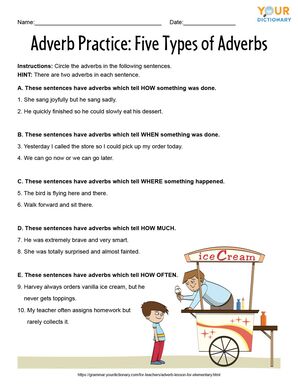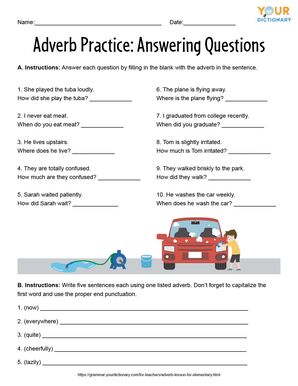

Following are some examples of adverb lesson plans for elementary school. These will introduce adverbs, explain what kind of words they modify, and show the different ways they modify words. The objective for these adverb lessons is that students will be able to identify adverbs and their purpose in a sentence.
Adverb Lesson 1: Five Types of Adverbs
Introduce adverbs and their functions with this beginner adverbs lesson. Using their prior knowledge of verbs and other parts of speech, students can identify what word the adverbs are modifying.
Introduction
Explain that an adverb gives more information about a word and changes it slightly. Tell the students that an adverb can modify a verb, adjective or other adverb. There are five different ways an adverb can change a verb: to show how, when, where, how much, or how often the action occurs.
Guided Practice
Write each of the following sentences on the board. Read each one aloud and underline the adverbs. Tell the students which word the adverb is modifying and in what way. Then ask the students to think of other adverbs that fit in the sentence.
- "He ran quickly to the park." Explain that "quickly" tells how he ran and that many adverbs explain how something happened. Ask for examples of other ways the man could run (happily, fearfully, energetically).
- "I came to school yesterday." Explain that "yesterday" tells when and ask for examples of other times when I could come to school. (this morning, every day, last week).
- "We can play inside." Explain that "inside" tells where and ask for examples of other places we can play (outside, there, here).
- "That was very nice of you." Explain that "very" tells how much and ask for examples of other ways to express how nice it was (really, kind of, pretty).
- “She always shares her lunch.” Explain that “always” tells how often she shares her lunch, and ask for examples of other ways that show how often she can share (sometimes, frequently, never).
Write each example that students name on the board. Summarize by going over the five categories of adverbs: how, when, where, how often, and how much.
Independent Practice
Ask students to write one sentence for each category (five total). They can use the words on the board or their own words. Have them share their sentences and give extra credit for creativity!
Assessment: Adverb Practice Sheet 1
Assign the “Adverb Practice: Answering Questions” worksheet. This practice sheet accompanies the first adverb lesson and demonstrates the student’s understanding of what an adverb is and what it does. You can find a preview and printable PDF, complete with answer key, below.
Instructions: Identify the adverbs in the following sentences. HINT: There are two adverbs in each sentence.
A. These sentences have adverbs which tell HOW something was done.
- She sang joyfully but he sang sadly.
- He quickly finished so he could slowly eat his dessert.
B. These sentences have adverbs which tell WHEN something was done.
- Yesterday I called the store so I could pick up my order today.
- We can go now or we can go later.
Answers: 1) joyfully, sadly 2) quickly, slowly; 1) yesterday, today 2) now, later

Adverb Lesson 2: Adverbs Answer Questions
As a final adverb lesson for elementary school, use this lesson to review and assess the student's understanding of adverbs.
Introduction
Go over adverbs and their categories: how, when, where, how often, and how much. Explain that adverbs tell you more about the word they modify.
Guided Practice
Write the following four adverbs (loudly, never, away, and really) on the board and work with students to make up sentences using them. Remind them that the adverb modifies the verb in each sentence.
Independent Practice
Split the class into groups and have them write short skits that include these four adverbs, plus four more of their choosing, in an interview. One student can pretend to be a celebrity and the others can be reporters. The reporters should ask the celebrity questions about how, when, where, how often, and how much they do something. Some possible interview questions include:
- How often do you practice your skills?
- Where do you like to perform?
- How should you play during a championship game?
- How much practice do you need to be successful?
- When was the last time you performed?
Assessment: Adverb Practice Sheet 2
Use the following “Adverb Practice: Four Types of Adverbs” as classwork or homework at the end of the lesson. Students will demonstrate their understanding of adverbs as ways to answer questions about verbs. Read the preview of the worksheet below and click on the PDF to download and print the document.
A. Instructions: Answer each question by finding the adverb in the sentence.
- She played the tuba loudly. How did she play the tuba?
- I never eat meat. How often do you eat meat?
- He lives upstairs. Where does he live?
- They are totally confused. How much are they confused?
- Sarah waited patiently. How did Sarah wait?
Answers: 1) loudly 2) never 3) upstairs 4) totally 5) patiently

Adverb practice worksheet answering questions
Click to View & DownloadTeaching Adverbs Effectively
Hopefully, your students will have a strong grasp on adverbs after completing these lessons. Activities on parts of speech help readers of all levels understand more about grammar and sentence structure. For more grammar lessons, check out these lesson plans about verbs.